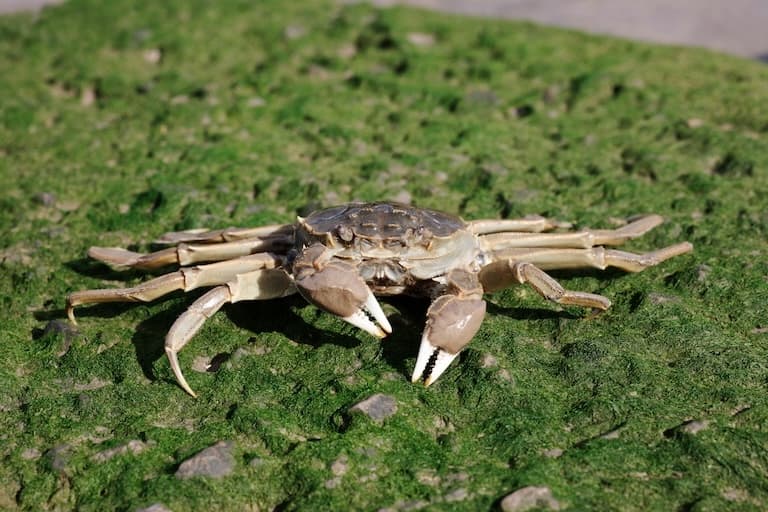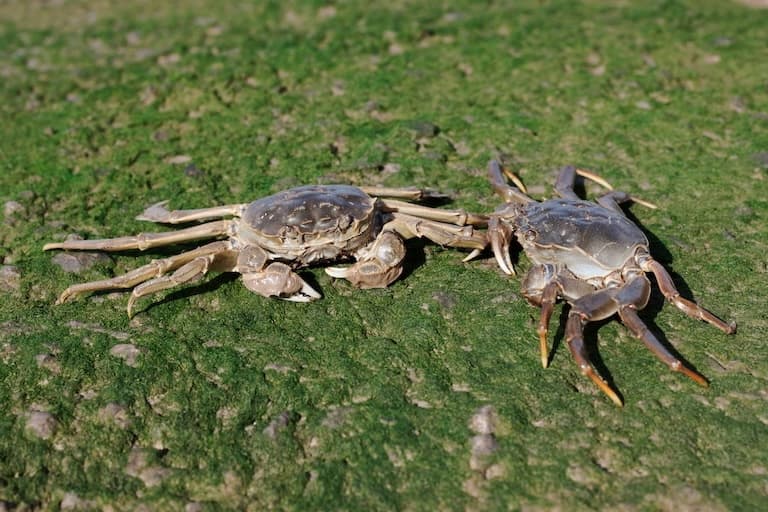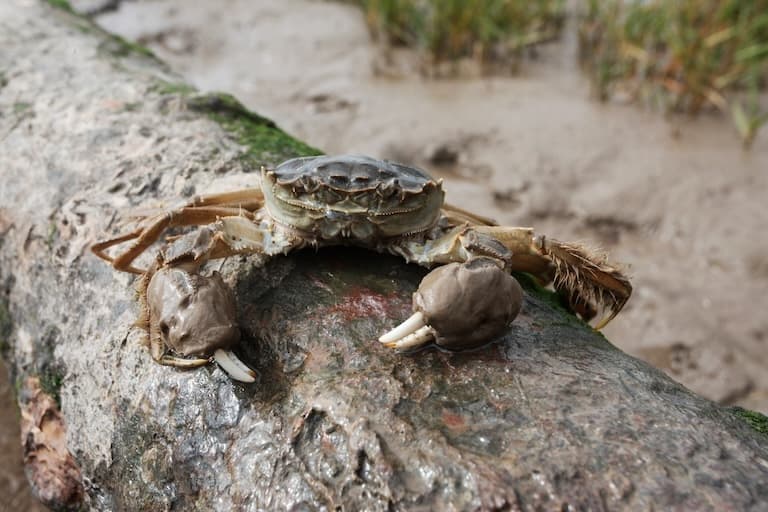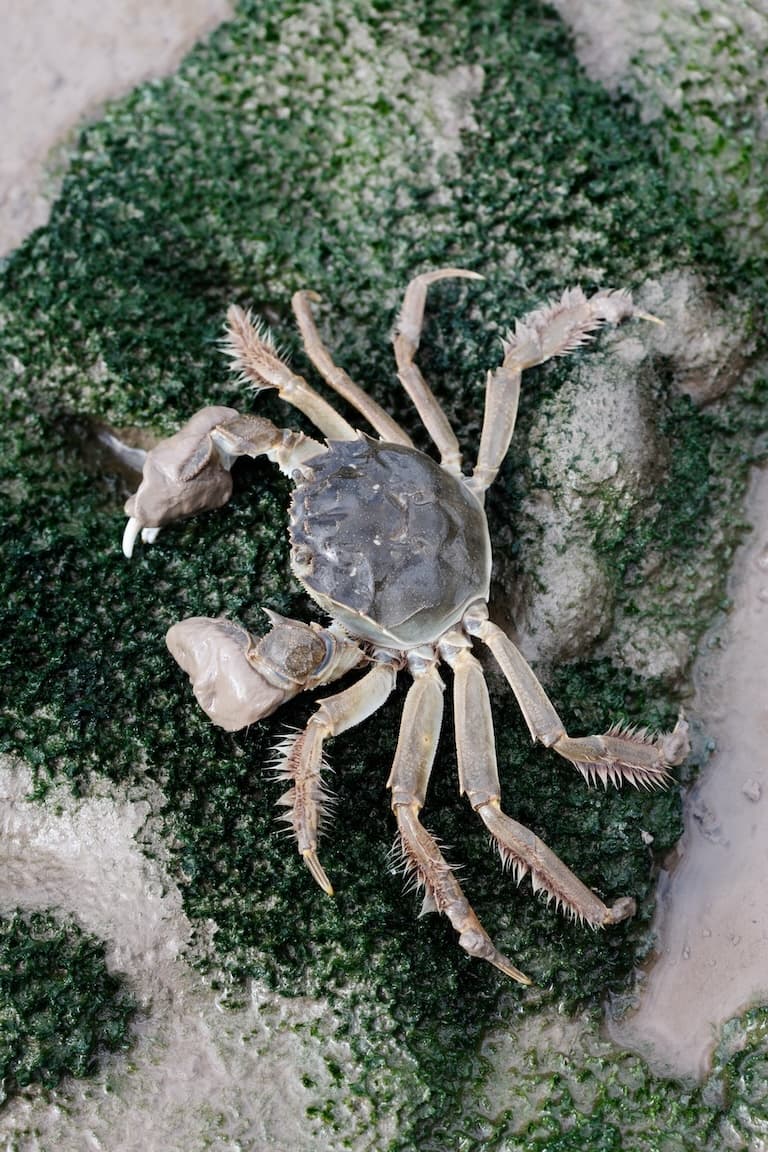Chinese Mitten Crab Profile
An infestation of Shanghai hairy crabs sounds like something that could easily be fixed with a prescription shampoo, but judging from its prevalence in both Europe and North America, the situation is more complicated than this.
And as it happens, this growing epidemic wasn’t brought back by a sailor after a visit to the so-called “Brothel of Asia”, but likely by commercial ships from Szczecin, carrying the free-swimming larvae of a crab in their bilge tanks.
A crab whose more common name is a lot cuter: the Chinese mitten crab.

Chinese Mitten Crab Facts Overview
| Habitat: | Freshwater, estuarine and marine systems |
| Location: | Native from Hong Kong to the border of Korea; introduced to Europe and North America |
| Lifespan: | Up to 5 years |
| Size: | About 30cm (1 ft) across, including legs. |
| Weight: | Around 170g (6oz) |
| Colour: | Sandy to dark brown with lighter legs |
| Diet: | Omnivorous, plants and invertebrates |
| Predators: | Fish, frogs, birds, otters, raccoons |
| Top Speed: | Not listed |
| No. of Species: | 1 |
| Conservation Status: | Not Listed |
Chinese mitten crabs are large, euryhaline crabs from Asia, named for their fluffy little claspers, which appear to be covered in hairs.
They’re a delicacy in their native range, and a potential hazard in ecosystems they’ve been accidentally introduced to, but these two points may work to cancel one another out if they can be selected as food while at the same time being removed as an invasive species.
Interesting Chinese Mitten Crab Facts
1. They have chest genitals
There’s a lot of confusion around crabs. Not only are there a lot of legit crabs, but it seems like everything in the ocean is evolving into crabs too, at least in appearance.
The crab’s tank-like body form is one of the most successful evolutionary solutions ever put forth by nature’s relentless trial and error method, and until DNA and molecular science came about, this meant it was hard to tell one crustacean from another.
But talk to any classical entomologist* and they’ll tell you about genitals. Entomologists love genitals and spend all day thinking about them. And that’s handy because arthropod genitals are often so distinctive, that they can be the entire basis for classification.
The Chinese mitten crab sits in a family of so-called thoracotrematan crabs, which is a clade of true crabs, differentiated by their peers by the position of their genitals.
In the thoracotrematans, their genital openings are in their sternums, which might sound weird, but it’s in relation to the Heterotrematans, whose males have their genitals in their legs.
The rest of this crab’s taxonomy is as confusing as it is boring, so we’ll save you the bother, but suffice it to say this is a very prevalent group with ecological importance in both freshwater and marine ecosystems.
* The discipline of entomology once included all arthropods, but entomology is now more strictly exclusive to insects, so the right title would be arthropodologist. But that is such a terrible word we’ll stick to “classical entomologist” until they come up with a better one. 1
2. They’re Euryhaline
This is a great word, stemming from the Greek halinos, meaning salty, and the also Greek eurus, meaning wide. Like DJT when he loses an election, these crabs are wide salty.
Essentially this means they can handle salinity levels in water over a wide range, and we see this in the mitten crab across its life cycle. They spend most of their lives somewhere between salty and fresh, in the brackish estuarine waters at the mouths of rivers, or further up in the freshwater of the rivers themselves.
Juveniles are spawned in the marine saltwater, some distance off the coast, and grow legs there, with which they amble on back through the estuarine waters into the rivers as they age.
Adults will then all join in a unified migration march back to the sea, clambering over obstacles and over various terrains to get there and make another batch of juvenile crabs to repeat the process, before returning themselves to their freshwater homes. 2
3. They’re large
This is quite a big crab, and while Asia has giants like the spider crab, Europe is not so lucky. In the Southern Baltic Sea, this is the largest species of crab and has few natural enemies as a result.
They can grow to around 30cm from toe to toe, with a carapace as large as a human hand. And speaking of hands, this crab—as the name makes clear—has mittens on. 3

4. They’re hairy
The hairy claws that give this animal its name are covered in dense clusters of setae, which are likely helpful as sensory organs or even as filtering devices to gather organic material from the water, though the purpose is seemingly unknown.
These hairs gave rise to its other, less flattering name: the Shanghai hairy crab. Despite this off-putting moniker, it is a highly regarded food source in large parts of Asia.
5. They’re a delicacy
In their natural environment, mitten crabs are prey for many larger animals. As a result, they breed fast and spread as quickly as possible.
Mitten crabs are so popular to eat, that there’s an entire industry focused on providing counterfeit crabs for consumption.
Hairy crabs from other locations are put to “bathe” in Yangcheng Lake for a couple of weeks and then sold erroneously as Yangcheng Lake crabs, which is a big deal to some people, for some reason.
Hong Kong, Taiwan and Japan sell upwards of 100,000 tonnes of fake “Yangcheng” crabs each year, in what is surely a matter of utmost importance and one for which we should all send our thoughts and prayers to the victims.
But there are more serious issues surrounding this animal. 4
6. They’re aliens
Their fast breeding, wide range, large size, and habit of burrowing into river banks all combine to make this quite a destructive species in ecosystems where it doesn’t belong.
In Europe and North America, it was thought to have been introduced by accident when trading vessels gathered up water for ballast in Asia, scooping up the crab larvae in the process.
On dumping the water out again in Europe, they went to town as the largest, and in places like Ireland’s rivers, the only crab in the ecosystem.
It is now considered invasive, but the solution could be just to eat it.

7. This could be a good thing
There are many easy arguments to be made against killing most animals for food, but there are times when it seems the unquestionably ethical thing to do, at least, given the circumstances.
In cases where the ecosystem suffers from either an introduced species or a native species whose predators no longer exist (see: deer), populations often have to be eradicated or maintained, respectively.
This happens through culling, and since this creates a bunch of free meat, making nutritional use of it seems like a no-brainer as it would be less negatively impactful on the environment even than a vegan alternative.
This is potentially the case with the Chinese mitten crab, whose presence is dangerous in Europe but may become useful nonetheless.
But it isn’t as easy as it sounds, and management is tricky. Catching all the crabs will likely involve catching a bunch of native stuff too.
Being a large animal, it’s possible that some kind of filtration method could work in the way of migration barriers to stop their reproduction, but so far, success is limited.

Chinese Mitten Crab Fact-File Summary
Scientific Classification
| Kingdom: | Animalia |
| Phylum: | Arthropoda |
| Class: | Malacostraca |
| Order: | Decapoda |
| Family: | Varunidae |
| Genus: | Eriocheir |
| Species: | sinensis |
Fact Sources & References
- C. D. Schubart (2006), “Molecular phylogeny of grapsoid crabs (Decapoda, Brachyura) and allies based on two mitochondrial genes and a proposal for refraining from current superfamily classification”, Wiley Online Library.
- Anna Solovyeva, “Eriocheir sinensis Chinese mitten crab”, Animal Diversity Web.
- “Invasion of the Hairy-clawed Crustaceans”, US Fish & Wildlife Service.
- Alice Yan, “Trade in fake Yangcheng Lake hairy crabs rampant”, my news.
